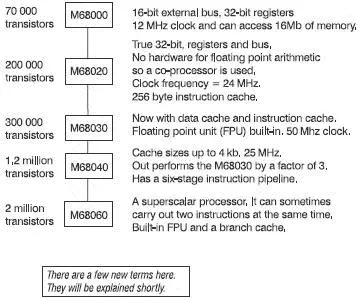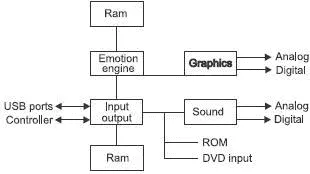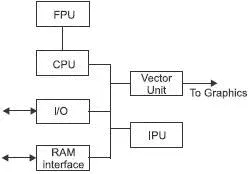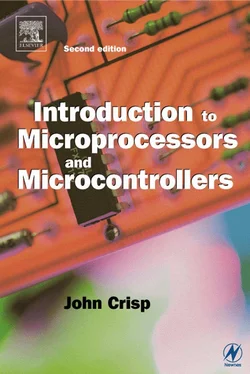John Crisp - Introduction to Microprocessors and Microcontrollers
Здесь есть возможность читать онлайн «John Crisp - Introduction to Microprocessors and Microcontrollers» весь текст электронной книги совершенно бесплатно (целиком полную версию без сокращений). В некоторых случаях можно слушать аудио, скачать через торрент в формате fb2 и присутствует краткое содержание. Год выпуска: 2004, ISBN: 2004, Издательство: Elsevier, Жанр: Компьютерное железо, на английском языке. Описание произведения, (предисловие) а так же отзывы посетителей доступны на портале библиотеки ЛибКат.
- Название:Introduction to Microprocessors and Microcontrollers
- Автор:
- Издательство:Elsevier
- Жанр:
- Год:2004
- ISBN:0-7506-5989-0
- Рейтинг книги:3 / 5. Голосов: 1
-
Избранное:Добавить в избранное
- Отзывы:
-
Ваша оценка:
- 60
- 1
- 2
- 3
- 4
- 5
Introduction to Microprocessors and Microcontrollers: краткое содержание, описание и аннотация
Предлагаем к чтению аннотацию, описание, краткое содержание или предисловие (зависит от того, что написал сам автор книги «Introduction to Microprocessors and Microcontrollers»). Если вы не нашли необходимую информацию о книге — напишите в комментариях, мы постараемся отыскать её.
Introduction to Microprocessors and Microcontrollers — читать онлайн бесплатно полную книгу (весь текст) целиком
Ниже представлен текст книги, разбитый по страницам. Система сохранения места последней прочитанной страницы, позволяет с удобством читать онлайн бесплатно книгу «Introduction to Microprocessors and Microcontrollers», без необходимости каждый раз заново искать на чём Вы остановились. Поставьте закладку, и сможете в любой момент перейти на страницу, на которой закончили чтение.
Интервал:
Закладка:
One interesting feature is that this microprocessor can operate in two modes, supervisory and user. The essential difference is that the user mode has a restricted list of instructions at its disposal. The operating system can use the supervisory mode and thus use the full set of instructions but user programs only have access to a restricted range – enough to run the programs but, hopefully, not enough to screw things up too much. There is a software route between the two modes if you really want to change.
The M68000 gave rise to its own family as the basic model progressed. The main advances are detailed in Figure 11.8.

Figure 11.8 The M68000 family
As true 32-and 64-bit microprocessors have taken over the computing side, the 68000 family is used increasingly as a high-performance embedded control for printers and disk drives.
After the early one-chip microcomputer, the decreasing cost of the design and production of the integrated circuits made it easier to increase the complexity of the chips.
This has caused the development to diverge along two separate paths: speed and power or cheap and small.
By heading off in the cheap and small route, we get microcontrollers that are controlling the operation of most of the instruments and machines that we use and even playing tunes in greetings cards. We will meet these in Chapters 15 and 16.
The never-ending pursuit of more speed and more power for computers has resulted in the continuous development of larger and faster microprocessors like the Pentium 4 and its competitors. Each new design is king for a day, and then overtaken and dispatched to the museum. What cost a fortune three years ago is thrown out with the garbage, unwanted. We will look at these here today, gone tomorrow devices in the next three chapters.
If we only needed computers to allow us to handle text on a word processor, there would be little need for the development that has occurred in the last ten years – our typing is not getting faster and text is simple stuff. Introducing coloured pictures does little to increase the stress levels but things really start to change when we want to have moving coloured pictures.
We are never satisfied: we want faster-changing, more lifelike images – with sound effects, of course. Our demands will outstrip the latest microprocessors almost regardless of their capability.
Many computers are used mostly for playing games and simulations but because they have other functions they must be designed to operate across a wide range of fields and not really optimized for any particular task. This has resulted in the development of the dedicated games machine. We have a choice of three at the moment – they are the Nintendo Gamecube, the Playstation and the X-Box.
Nintendo Gamecube
This is the oldest design and, inevitably, the least technically advanced. It is generally cheap to buy the cube and the games are also cheap and are most popular amongst users in the lower age groups.
They decided to use a 64-bit, 85 MHz, IBM PowerPC 750Cxe microprocessor, also called the ‘Gekko’ which was its original codename during the production stages. It is a slightly modified version of the one used in Macintosh computers and similar to those described in Chapter 13. The modifications were software additions of almost forty additional instructions to provide specific help in game playing but not necessary in the original computer applications.
The quality of the graphics during play can be indicated by the speed of handling graphic data which is conveniently measured by how many shapes it is able to draw in one second. In this case the chosen ATI 162 MHz Flipper GPU (Graphics Processor Unit) has a maximum speed of 12 million polygons/second – this sounds fast but compared with the Playstation 2 and the X-box it is not impressive.
The main game storage is a 1.5 GB 3 inch Nintendo optical disk. There is also a facility for a 64 MB memory card supplied by Panasonic.
Sony Playstation 2
Rather than taking a ready-made microprocessor off the shelf and then designing a games machine around it, Sony started by designing their own microprocessor called the ‘Emotion Engine’ designed just to run games programs as fast as possible. This ‘single job’ approach allows the design to be very focused. The microprocessor is surrounded by the necessary circuitry to provide the necessary inputs and outputs. The overall blocks are shown in Figure 11.9.

Figure 11.9 Playstation 2
If we load a game from a DVD, the startup information is passed to the Emotion Engine which prepares the game graphics and sound in either analog or digital format. It then waits for input instructions arriving from our controller or through the USB ports.
Inside the Emotion Engine, shown in Figure 11.10, our controller information arrives through the Input/Output unit and the fun begins.

Figure 11.10 The Emotion Engine
Games involve serious numbers of calculations and they can be very complex. There are two types of calculations: straightforward calculations (just the sort of thing we could do on a pocket calculator) and geometric calculations. The ordinary calculations are performed by the FPU (Floating-Point Unit) and the others are done by the VU (Vector Unit). So why so many calculations?
Does the car skid on the corner? This depends on how fast you are telling it to turn, what speed you are driving at, the weather selected and the car data. What is going to happen if you ‘accidentally’ hit a tree or another vehicle?
These calculations have to be done in real time – if we turn the steering wheel the car has to respond immediately. The geometric calculations are performed by the Vector unit, which provides the results of what is happening on screen. It also prepares the list of events that control everything that appears on the screen – right down to the path taken by the wheel that has broken off and the reflection in the driver’s mirror.
To a large extent, the final quality of the game experience depends on the speed of these calculations. Floating point calculations are performed at more than six billion a second! That is moving.
So, how good is the Playstation 2?
That is too difficult to answer. Instead we can look at the technical information but there is much more. Does the controller feel good? Are the games exciting and realistic? Does an hour on the PS2 seem like minutes or weeks?
Generally, the console is fairly expensive but, having bought it, the games are cheap(ish). The thinking behind this is we only buy the PS2 once and soon forget how much it cost, especially if it was a gift, but we can afford plenty of games. Having plenty of games reduces the attraction of changing to another games machine – like the Xbox.
The Emotion Engine runs at only 294 MHz but these headline speeds are not a good indication of how fast it can do its job – this also depends on how well it has been designed for the job. You may remember that the Gamecube microprocessor was running at 485 MHz, more than 50% faster than the PS2, but look at the drawing speeds: Gamecube 12 million polygons/sec, PS2 25 million polygons/sec, double the speed. This compares a general-purpose computer microprocessor with a dedicated device.
Читать дальшеИнтервал:
Закладка:
Похожие книги на «Introduction to Microprocessors and Microcontrollers»
Представляем Вашему вниманию похожие книги на «Introduction to Microprocessors and Microcontrollers» списком для выбора. Мы отобрали схожую по названию и смыслу литературу в надежде предоставить читателям больше вариантов отыскать новые, интересные, ещё непрочитанные произведения.
Обсуждение, отзывы о книге «Introduction to Microprocessors and Microcontrollers» и просто собственные мнения читателей. Оставьте ваши комментарии, напишите, что Вы думаете о произведении, его смысле или главных героях. Укажите что конкретно понравилось, а что нет, и почему Вы так считаете.












